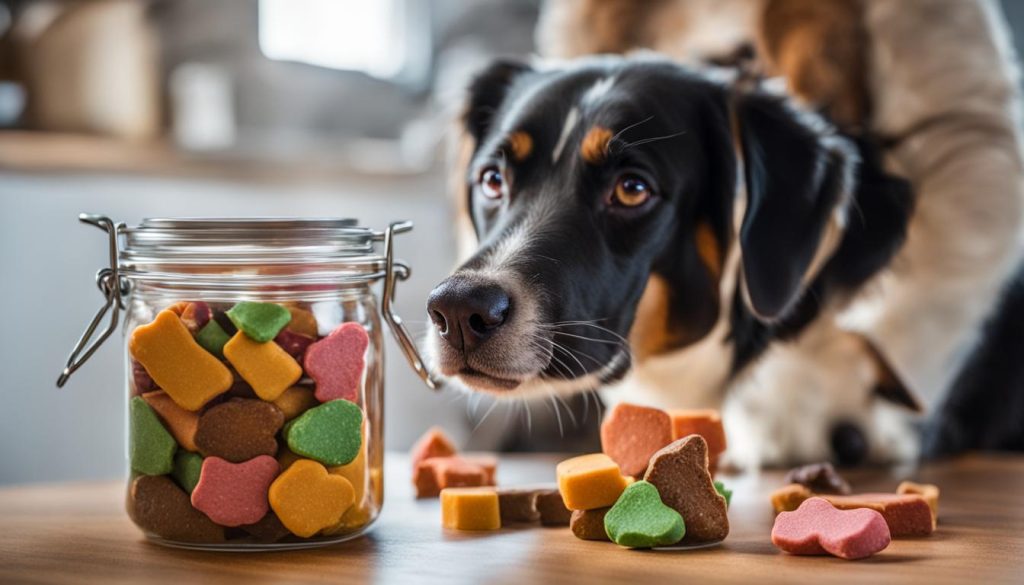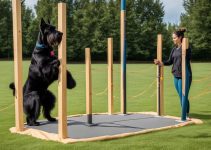In recent years, positive reinforcement with dogs has gained popularity as a highly effective and humane approach to dog training techniques. At the heart of this method lies the concept of reward-based training and operant conditioning, which focus on using praise, treats, and other rewards to motivate canines to exhibit good behavior. When employed consistently and correctly, this behavioral training method can not only teach dogs basic commands but also help address more complex behavioral issues, paving the way to a well-mannered canine companion. In this guide, I will provide an in-depth exploration of positive reinforcement in dog training, as well as useful tips and best practices to help you and your furry friend succeed.
Positive Reinforcement with Dogs
- Positive reinforcement with dogs is a humane and effective dog training technique that uses rewards to encourage good behavior.
- Operant conditioning forms the basis of positive reinforcement, wherein desired actions are reinforced through rewards.
- Appropriate timing and consistency are crucial for the success of reward-based training.
- Selecting the right treats and toys can greatly enhance the effectiveness of positive reinforcement training.
- Behavioral training methods like positive reinforcement can address common behavioral problems in dogs, resulting in a better-adjusted canine companion.
Understanding the Principles of Positive Reinforcement
Positive reinforcement is a cornerstone of effective dog training, relying on the principles of operant conditioning to modify canine behavior. This method involves adding something pleasant to increase the likelihood of a behavior occurring again, such as giving treats or toys when a dog performs a desired action.
With this approach, dogs associate positive outcomes with specific behaviors, which in turn encourages them to repeat those behaviors. By incorporating the principles of positive dog training in their training regimen, dog owners and trainers can respect the dog’s well-being, foster a trusting relationship, and achieve better results in teaching desired behaviors.
Operant conditioning, as a psychological theory, was developed by B.F. Skinner. In this theory, positive reinforcement is considered one of the four primary types of consequences for behavior. Specifically, it involves providing a favorable stimulus following a desired behavior to make it more likely for that behavior to occur again in the future. This approach is particularly effective with dogs, as it aligns with their natural inclination to seek pleasurable experiences and form strong associations between actions and outcomes.
Understanding and applying the principles of positive reinforcement with dogs involves the timely delivery of rewards in response to desired behaviors, consistency in training practices, and gradual adaptation of reward schedules to maintain a dog’s engagement and motivation. Mastering these principles can help dog owners and trainers develop a successful training regimen that respects the dog’s well-being and fosters a trusting relationship while achieving long-lasting results.
The Significance of Timing in Reward-Based Dog Training
In reward-based dog training, the timing of reinforcement is crucial for effectively conveying the desired message to your furry companion. Immediate reinforcement ensures that dogs associate the reward with the correct action, which in turn, encourages the repetition of the desired behavior. On the other hand, delays in rewarding can lead to confusion and the reinforcement of unintended behaviors, ultimately disrupting the learning process.
Misconceptions About Timing and Rewards
There are several misconceptions about timing in dog training, one of which is the belief that rewards can be given at any point. While dogs are indeed intelligent, their cognitive abilities are not the same as humans. Consequently, they may fail to connect an action to a reward if the reinforcement is given too late, making it challenging for them to understand which behavior is being reinforced.
One effective way to master reward timing is through clicker training – a technique that uses a small device that emits a clicking sound to signal the desired behavior to the dog. By using clicker training, the sound quickly becomes associated with a positive experience, allowing both trainer and dog to communicate clearly and efficiently.
Examples of Optimal Reward Timing
Optimal reward timing in dog training involves delivering a treat or praise within seconds of the desired behavior being performed. For instance, if you are teaching your dog to sit, it is important to reward them immediately after they sit down, rather than when they have already moved onto another action.
Here are some examples of optimal reward timing:
- Rewarding your dog for sitting down as soon as their rear end touches the ground
- Praising and treating your dog for laying down when their belly makes contact with the floor
- Providing reinforcement immediately after your dog makes eye contact when called by name
By consistently practicing optimal reward timing, you will be able to effectively communicate with your dog and enhance the efficiency of your training sessions. This will inevitably lead to a rewarding and positive dog training experience that promotes a strong bond between you and your canine companion.
1. Selecting the Perfect Treats and Toys for Positive Reinforcement
Choosing the right treats and toys for positive reinforcement is an important part of successful dog training. Treats should be irresistible to the dog and small enough to consume quickly, avoiding distractions during training sessions. A variety of treats can prevent boredom, and coupling treats with verbal praise further reinforces the desired behavior.

When selecting dog treats for positive reinforcement, consider the size, texture, and flavor of the treat. Small treats are ideal, as they allow for quick consumption and a seamless continuation of the training process. Soft treats are often preferable, as they can be easily broken into smaller pieces and quickly consumed by the dog.
Offering a range of treat flavors can help you tap into your dog’s preferences, ensuring they remain interested and engaged throughout training. In addition, rotating between different treats can prevent your dog from becoming bored with the same flavor. High-value treats, like freeze-dried liver or cooked chicken, can be particularly effective during training sessions that require increased focus and motivation.
Similarly, toys can serve as an excellent method of positive reinforcement with dogs, particularly for dogs that may not be as food-motivated. Toys should be engaging and serve as a motivational reward for the dog, enhancing the training experience and the dog’s willingness to participate.
Selecting the right toys for your dog is a matter of trial and error. Some dogs may be motivated by plush toys, while others may prefer rubber balls or tug toys. Experiment with different types of toys to discover what motivates your dog the most and use these toys as rewards for successful training sessions.
Selecting the perfect treats and toys for positive reinforcement is crucial for an effective and enjoyable training experience. By providing irresistible treats and engaging toys, you can create an environment where your dog is motivated and eager to participate, leading to successful training and a strong bond between you and your furry friend.
2. Teaching Basic Commands with Positive Techniques

One of the most important aspects of successful dog training is implementing consistency in dog training. A consistent approach involves using the same cues, delivering rewards for good behavior, and avoiding rewards for unwanted actions. This consistency ensures that dogs can clearly understand the behaviors being reinforced, leading to quicker learning and more reliable obedience.
The Role of Consistency in Behavioral Training Methods
Behavioral training methods are most effective when they’re based on a consistent approach to rewarding desired behaviors and ignoring or redirecting undesirable ones. This helps your canine companion establish a strong understanding of the expected behaviors, as well as a positive relationship with you, leading to a more well-behaved and responsive pet.
With positive reinforcement with dogs, it’s important to reward your dog consistently for their desired behavior—whether with treats, praise, or playtime—and do so immediately after the desired action is performed. This ensures they can make a clear connection between their actions and the positive outcome. Over time, your dog will learn to associate specific behaviors with rewards, so they’ll be more likely to repeat them in the future when they want something they enjoy.
Transitioning from Continuous to Intermittent Reinforcement
When you first start training your dog, you’ll likely use a form of continuous reinforcement, in which you reward your dog every time they perform the desired behavior. This helps them quickly learn what you expect of them and start responding to your cues more consistently.
As their behavior becomes more predictable and reliable, you can gradually shift to intermittent reinforcement, in which you reward their good behavior only occasionally. This unpredictable reward schedule helps to maintain your dog’s engagement and motivation, as they’ll continue to perform desired behaviors in anticipation of a potential reward.
This reward-based training method keeps your dog guessing, making their learning experience more exciting and enjoyable. Moreover, intermittent reinforcement reinforces to your dog that good behavior is intrinsically valuable, promoting their continuous performance of these behaviors even when rewards aren’t directly provided.
Consistency is key when it comes to teaching basic commands using positive reinforcement techniques. With a strong foundation of consistency, well-timed rewards, and the transition from continuous to intermittent reinforcement, you can effectively train your dog to be a well-mannered and responsive companion.
3. Addressing Common Behavioral Issues through Positive Reinforcement
Positive reinforcement is a powerful tool for dog behavior modification, helping to address common behavioral issues in our canine friends. By rewarding the desired behaviors and either ignoring or redirecting the undesirable ones, we can effectively teach our dogs which actions lead to positive outcomes. In turn, this creates a more harmonious living environment and a well-adjusted pet.
For instance, excessive barking is a common issue that can be addressed through positive reinforcement with dogs. Instead of punishing the barking, a trainer employing this method would reward the dog when they are quiet – either by offering treats or praise. As a result, the dog makes an association between being quiet and receiving a reward, which prompts them to modify their behavior accordingly.
Another example is addressing leash-pulling. A dog that constantly pulls while on a walk can be frustrating and even dangerous for both the handler and the dog itself. By using positive reinforcement techniques like treating and praising the dog when they walk calmly by your side, they will learn to associate a loose leash with rewards, which in turn encourages them to maintain this desirable behavior.
In addition to its efficacy in mitigating unwanted behaviors, positive reinforcement also promotes a more compassionate and supportive approach to training. Unlike aversive methods that rely on punishment or fear, positive reinforcement techniques focus on building a strong bond between handler and dog. This not only creates an enjoyable training experience for both parties but also fosters trust and understanding, which are crucial for a successful relationship.
With patience, consistency, and understanding, positive reinforcement can lead to significant improvements in our dogs’ behavior, making a world of difference in our shared lives. Embracing this method helps ensure that our dogs grow into well-mannered and happy companions while preserving the loving bond we share with them.
READ: Mastering the Art of Training a Dog to Walk on Leash
Conclusion
In summary, implementing positive reinforcement with dogs is an essential instrument in modern dog training. This method supports the fundamental principles of operant conditioning, building a strong and trusting bond between the dog and the handler. Employing these force-free training techniques not only teaches desired behaviors but also effectively addresses common behavioral issues.
Key factors of successful positive dog training lie in selecting enticing treats and toys, utilizing consistent and well-timed rewards, and laying a foundation of basic commands. By continuously applying these techniques and employing consistent, well-timed rewards, dog owners ensure a well-behaved and responsive canine companion throughout their lives.
Embracing positive reinforcement allows for a rewarding and humane approach to training, ultimately fostering a happy and harmonious living environment for both the dog and the owner. With the right understanding, patience, and dedication, you can create a learning environment where your dog is consistently motivated to perform well and exhibit excellent behavior.
FAQ
What is positive reinforcement in dog training?
Positive reinforcement is a dog training technique based on operant conditioning, which involves rewarding desired behaviors with praise, treats, or toys. This method encourages dogs to repeat the behaviors associated with positive outcomes, leading to well-mannered and well-adjusted dogs.
Why is timing important in reward-based dog training?
Timing is crucial in reward-based dog training because immediate reinforcement ensures that dogs associate the reward with the correct action. Delays in rewarding can lead to confusion and could reinforce unintended behaviors. Mastering optimal reward timing, such as through clicker training, is vital to effective dog training.
How do I select the right treats and toys for positive reinforcement?
Choose treats that are irresistible to your dog, small enough for quick consumption, and varied to prevent boredom. Combine treats with verbal praise for added reinforcement. Toys should be engaging and serve as a motivational reward, enhancing your dog’s willingness to participate in training sessions.
How do I use consistency and reinforcement schedules in dog training?
Consistency is essential in dog training, meaning you should use the same cues, reward good behavior consistently, and never reward unwanted actions. Initially, use continuous reinforcement (rewarding every time a new desirable behavior is displayed). Once the behavior is established, gradually transition to intermittent reinforcement to keep your dog engaged and motivated.
Can positive reinforcement help address common behavioral issues in dogs?
Yes, by rewarding desirable behaviors and ignoring or redirecting undesirable ones, dogs learn which actions are beneficial to them. This approach helps modify problematic behaviors in a humane and supportive manner, creating a harmonious living environment and a well-adjusted dog.






